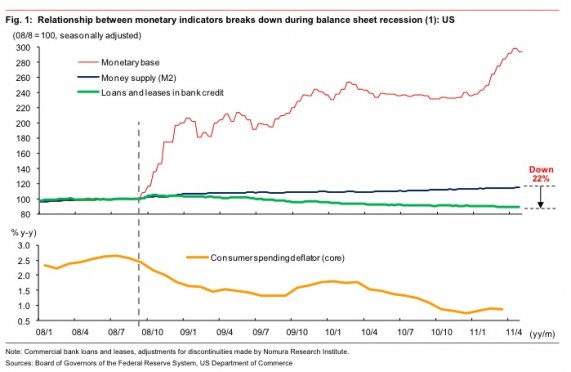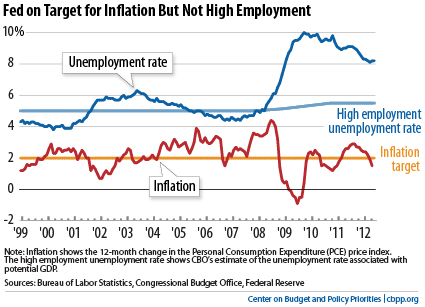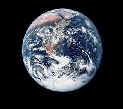www.aljazeerah.info
Opinion Editorials, September 2012
Archives
Mission & Name
Conflict Terminology
Editorials
Gaza Holocaust
Gulf War
Isdood
Islam
News
News Photos
Opinion Editorials
US Foreign Policy (Dr. El-Najjar's Articles)
www.aljazeerah.info
Why QE3 Won't Jumpstart the Economy and What Would
By Ellen Brown
Al-Jazeerah, CCUN, September 24, 2012
The economy could use a good dose of “aggregate demand”—new spending money
in the pockets of consumers—but QE3 won’t do it.
Neither will it trigger the dreaded hyperinflation.
In fact, it won’t do much at all.
There are better alternatives.
The Fed’s announcement on September 13, 2012, that it was embarking on a
third round of quantitative easing has brought the “sound money” crew out
in force, pumping out articles with frighting titles such as
“QE3
Will Unleash' Economic Horror' On The Human Race.”
The Fed calls QE an asset swap, swapping Fed-created dollars for other
assets on the banks’ balance sheets.
But critics call it “reckless money printing” and say it will
inevitably produce hyperinflation.
Too much money will be chasing too few goods, forcing prices up and
the value of the dollar down.
All this
hyperventilating could have been avoided by taking a closer look at how QE
works. The money created by
the Fed will go straight into bank reserve accounts, and
banks can’t lend their reserves.
The money just sits there, drawing a bit of interest.
The Fed’s plan is to buy mortgage-backed securities (MBS) from the
banks, but according to the Washington Post, this is
not expected to be of much help to homeowners either.
Why QE3 Won’t Expand the Circulating
Money Supply
In its third round of QE,
the Fed says it will buy
$40 billion in
MBS every month for an indefinite period.
To do this, it will essentially create money
from nothing, paying for its purchases by crediting the reserve accounts
of the banks from which it buys them.
The banks will get the dollars and the Fed
will get the MBS.
But the banks’ balance sheets will remain
the same, and the circulating money supply will remain the same.
When the Fed engages
in QE, it takes away something on the asset side of the bank’s balance
sheet (government securities or mortgage-backed securities) and replaces
it with electronically-generated dollars.
These dollars are held in the banks’ reserve
accounts at the Fed.
They are “excess reserves,” which cannot be
spent or lent into the economy by the banks.
They can only be lent to other banks that
need reserves, or used to obtain other assets (new loans, bonds, etc.).
As Australian economist
Steve Keen explains:
[R]eserves are there for settlement of accounts
between banks, and for the government's interface with the private banking
sector, but not for lending from. Banks
themselves may . . . swap those assets for other forms of assets that are
income-yielding, but they are not able to lend from them.
This was also explained by Prof. Scott Fullwiler, when
he argued a year ago for another form of QE—the minting of some trillion
dollar coins by the Treasury (he called it “QE3
Treasury Style”). He
explained why the increase in reserve balances in QE is not inflationary:
Banks can’t “do” anything with all the extra reserve
balances. Loans create
deposits—reserve balances don’t finance lending or add any “fuel” to the
economy. Banks don’t lend reserve balances except in the federal
funds market, and in that case the Fed always provides sufficient
quantities to keep the federal funds rate at its . . . interest rate
target. Widespread belief that reserve balances add “fuel” to bank lending
is flawed, as I explained here over
two years ago.
Since November
2008, when QE1 was first implemented, the monetary base (money created by
the Fed and the government) has indeed gone up.
But the circulating money supply,
M2, has not increased any faster than in the previous decade, and
loans have actually gone down.
Quantitative
easing has had beneficial effects on the stock market, but these have been
temporary and are evidently psychological: people THINK the money supply
will inflate, providing more money to invest, inflating stock prices, so
investors jump in and buy.
The psychological effect eventually wears off, requiring a new round of QE
to keep the game going.
That is what
happened with QE1 and QE2.
They did not reduce unemployment, the alleged target; but they also did
not drive up the overall price level.
The rate of price inflation has actually been
lower after QE
than before the program began.
Why, Then, Is the Fed
Bothering to Engage in QE3?
If the Fed is doing
no more than swapping bank assets, what is the point of this whole
exercise?
The Fed’s professed justification is that by
buying mortgage-backed securities, it will lower interest rates for
homeowners and other long-term buyers.
As explained in Reuters:
Massive buying of any
asset tends to push up the prices, and because of the way the bond market
works, rising prices force yields [or interest rates] down. Because the
Fed is buying mortgage-backed bonds, the purchases act to directly lower
the cost of borrowing to buy a home. In addition, some investors, put off
by the rising price of the bonds that the Fed is buying, turn to other
assets, like corporate bonds - which, in turn, pushes up corporate bond
prices and lowers those yields, making it cheaper for companies to borrow
- and spend.
Those are the
professed objectives, but politics may also play a role.
QE drives up the stock market in
anticipation of an increase in the amount of money available to invest, a
good political move before an election.
Commodities (oil,
food and precious metals) also go up, since “hot money” floods into them.
Again, this is evidently because investors
EXPECT inflation to drive commodities up, and because lowered interest
rates on other investments prompt investors to look elsewhere.
There is also evidence that commodities are
going up because some major market players are
colluding to manipulate the price,
a criminal enterprise.
The Fed does bear
some responsibility for the rise in commodity prices, since it has created
an expectation of inflation with QE, and it has kept interest rates low.
But the price rise has not been from
flooding the economy with money.
If dollars were flooding economy, housing
and wages (the largest components of the price level) would have shot up
as well.
But they have remained low, and overall
price increases have remained within the Fed’s 2% target range.
(See chart above.)
Some Possibilities That Might
Be More Effective at Stimulating the Economy
An injection of money
into the pockets of consumers would actually be good for the economy, but
QE3 won’t do it.
The Fed could give production and employment
a bigger boost by using its lender-of-last-resort status in more direct
ways than the current version of QE.
It could make the
very-low-interest loans given to banks available to state and municipal
governments, or to students, or to homeowners.
It could rip up the $1.7 trillion in
government securities that it already holds, lowering the national debt by
that amount (as
suggested a year ago by Ron Paul).
Or it could
buy up a trillion dollars’ worth of securitized
student debt and rip those securities
up.
These moves might require some tweaking of the
Federal Reserve Act, but Congress has done it before to serve the banks.
Another possibility
would be the sort of “quantitative easing” first proposed by Ben Bernanke
in 2002, before he was chairman of the Fed—just drop hundred dollar bills
from helicopters.
(This is roughly similar to the Social
Credit solution proposed by C. H. Douglas in the 1920s.)
As
Martin Hutchinson observed
in
Money Morning:
With a U.S. population of 310 million, $31 billion per month, dropped from
helicopters, would have given every American man, woman and child an extra
crisp new $100 bill per month.
Yes, it would produce an extra $31 billion per
month on the nominal Federal budget deficit, but the Fed would have
printed the new bills, so there would have been no additional strain on
the nation's finances.
It would be much better than a new social program,
because there would have been no bureaucracy involved, just bill printing
and helicopter fuel.
The money would nearly all have been spent,
increasing consumption by perhaps $300 billion annually, creating perhaps
3 million jobs, and reducing unemployment by almost 2%.
None of these moves
would drive the economy into hyperinflation.
According to the Fed’s figures, as of July
2010, the money supply was actually
$4 trillion LESS than it was in 2008.
That means that as of that date, $4 trillion
more needed to be pumped into the money supply just to get the economy
back to where it was before the banking crisis hit.
As the psychological
boost from QE3 wears off and the “fiscal cliff” looms, perhaps Congress
and the Fed will consider some of these more direct approaches to
relieving the economy’s intractable doldrums.
_______
Ellen Brown is an attorney and president of the Public
Banking Institute. In Web
of Debt, her latest of eleven books, she shows how a private cartel
has usurped the power to create money from the people themselves, and how
we the people can get it back. Her websites are
http://WebofDebt.com,
http://EllenBrown.com, and
http://PublicBankingInstitute.org.
|
|
|
|
||
|
||||||




